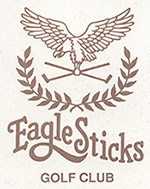 Described on our forum as “Augusta Junior,” Eagle Sticks Golf Club has at least one thing in common with the famous Georgia course: the entrance is right off a street filled with strip malls, fast food, and small retail buildings. The course is also set among hilly terrain, like Augusta National, but the comparisons really stop there. Eagle Sticks was not designed by Alister MacKenzie. I doubt if any top-ranking pro aspires to play there. And, as hard as I looked, I couldn’t spot a single azalea anywhere on the course!
Described on our forum as “Augusta Junior,” Eagle Sticks Golf Club has at least one thing in common with the famous Georgia course: the entrance is right off a street filled with strip malls, fast food, and small retail buildings. The course is also set among hilly terrain, like Augusta National, but the comparisons really stop there. Eagle Sticks was not designed by Alister MacKenzie. I doubt if any top-ranking pro aspires to play there. And, as hard as I looked, I couldn’t spot a single azalea anywhere on the course!
Fortunately for golfers, Eagle Sticks is a fun, well-designed, and relatively inexpensive track for golfers east of Columbus, OH. I had the chance to play Eagle Sticks in early May, and after hearing the “Augusta Junior” moniker, I couldn’t possibly help but be disappointed when reality didn’t quite meet expectations. Right? Wrong – Eagle Sticks impressed me enough that I’m trying to find a way to get back to the course, despite the four-hour drive, to play again.
Conditions
Golf courses in the northeastern United States have had a hard time getting started this year. April was incredibly cold and most of the northeast had snow (snow!) on Easter day. As late as mid-May, golf courses in the region were still showing signs of spring aeration. Fairways and rough had yet to perk up. Greens were bumpy and slow. Everything was soft, wet.
Well, virtually everything. Eagle Sticks was in near-perfect shape. Perhaps, being further away from Lake Erie’s cooling spring waters, Zanesville, OH did not have as brutal a spring as the more northern parts of Ohio. Perhaps the maintenance staff is really good. Perhaps it’s just a hardy golf course that drains really well.
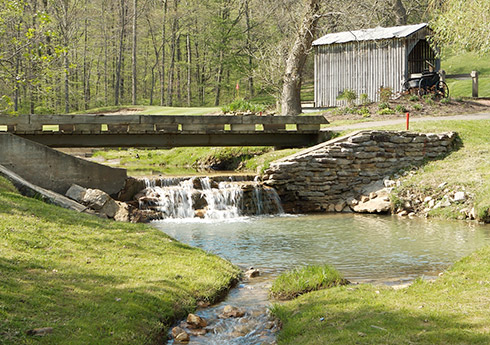
Yes, it’s a waterfall on a golf course, but unlike most this one’s natural. And small.
Fairways at Eagle Sticks were plush without being overly verdant. The ball sat up nicely and divots were crisp. The rough was equally plush and thick – a ball sitting down was tough to get to, and a ball sitting up was almost as if on a tee. The rough was thus a roll of the dice – you could get lucky or pay the price, depending on fate.
The greens, despite having been aerated only a few weeks prior to my visit, rolled very smoothly. I suspect that the speed of the greens on the course was slightly different than the large practice green, but I can’t verify that and the difference was slight if it existed at all. The greens weren’t lightning fast, but the ball rolled out generously and stayed online.
The only real flaw was the bunkers. Eagle Sticks is reputed to have great bunkers, but when I was there, I found only mud-like rocky sand in the bunkers. I was relieved to find out that the yearly addition of sand to the bunkers had not yet taken place for fear of driving heavy trucks on the wet golf course. The bunkers, in the words of the head pro, “are designed for greatness and aren’t the most economical bunkers in Ohio by any stretch. They’re the most expensive maintenance item at Eagle Sticks and something we work on constantly.” The yearly addition of new sand has since taken place, and I’m sure the several people who told me the bunkers are exceptional aren’t likely wrong.
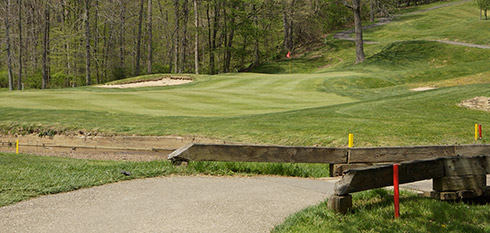
The third green is well protected by slopes left and right that can kick wayward shots out of bounds.
Eagle Sticks features the type of driving range that makes you feel good – even chunked wedges go 70 yards off the elevated practice area. Flags are marked at various distances, and by the time you get to about 160 yards, the terrain is flat. I didn’t spot a practice bunker or short game area, but the practice putting green is rather large and features enough slope at one end to really practice uphill and downhill putts.
Design and Layout
Designed by the increasingly popular Hurzdan Design Group of Columbus, OH, Eagle Sticks is routed among some of the hilliest terrain you’re likely to find in southeastern Ohio. The site was an old horse farm, and headstones around the course mark the graves of some of the horses that remain buried there.
Virtually every course has a weak hole, but golfers would be hard pressed to find one at Eagle Sticks. Like Little Mountain, another Hurzdan course we’ve reviewed, the course fits the land nicely and presents both holes on which you can attack and holes on which a conservative strategy is best.
The weakest set of holes at Eagle Sticks may be the par threes, and they’re only weak relative to the other holes on the course. Plop most of the five one-shot holes from Eagle Sticks on any other course and you’re very likely to improve that other course. But we’ll talk about the wonderful two- and three-shot holes later…
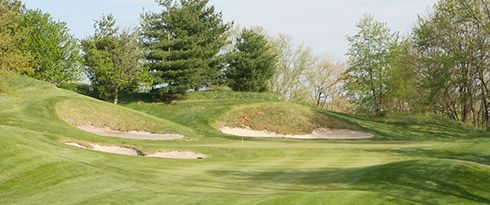
The short par-three 17th green doesn’t seem to offer much in the way of landing area. Be precise!
The two par threes on the front measure 171 and 151 from the back tees. The second hole plays to a narrow green with a steep ridge back left. When I played, the pin was tucked there, and I discovered (I’d like to say on purpose, but my playing partners would suggest it was all luck) that the best shot is actually left of the green, where a mound in the rough feeds the ball to the green. I made the five-foot putt for birdie, but realistically, the smart play is to the center of the green. Most days, with the pin down, the ridge serves as a good backstop to feed the ball to the back or center pin positions.
The fifth hole is a bit of a snore: a large, sloping green playing 151 yards at the most. I hit what I thought was a good shot only to see the ball continue to roll out to 40 feet from the pin. The pin happened to be tucked on a slope that resulted in about a foot of break on a two-foot putt, but I can chalk that up to one of the advantages of local knowledge – just play to stay below the hole on the fifth green.
The back nine features par threes at the 10th, 12th, and 17th. The 12th features a three-tiered green and measures 180 from the back tees. Distance control and direction are at a premium here – you don’t want to putt up or down the slopes, and missing right and left of the rather narrow green is no fun either. The 17th is an unassuming hole measuring only 151 up a slight hill. However, built against a slope from left to right, misses left are heavily penalized. Right isn’t much of a picnic either, but at least you’ll have an uphill putt or chip.
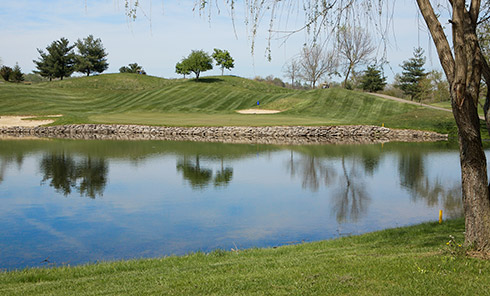
The 191-yad par-three 10th hole is as beautiful as it is dangerous, and is easily the best one-shot hole on the course.
These par threes are adequate, and again, better than most you’ll find elsewhere. The 10th, on the other hand, is an exceptional hole. Playing 193 yards over water (and, the day we played, into a little breeze), the shallow, wide green is completely fronted by water and a large hill and a few little bunkers in the back. The hole is beautiful, intimidating, and fair. It’s also probably the longest club you’ll hit into a green all day, so enjoy the challenge.
Eagle Sticks, playing to a par of 70, has an extra par three and is short a par five from the standard par-72 layout. The par fives – the third, 11th, and 18th – play 493, 591, and 541 yards, respectively.
All but the 11th are reachable, with the third being the easiest to get at in two. A reasonable downhill drive at the third leave as little as 200 yards (or less) to the green, but your approach shot had better be accurate. As I discovered, an approach shot that misses the green leaves an awkward or impossible chip or pitch, and that’s only if your approach doesn’t just decide to roll out of bounds.
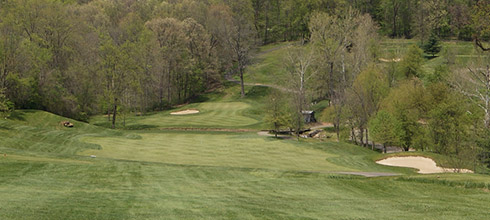
The short par-five third hole goads you into going for the green after all but the worst of drives, making every pin a sucker pin. I’m not ashamed to admit it: I was suckered, and I paid the price as I faced a tough pitch left of the green.
I really enjoyed this hole, though, because with all but the worst of drives, you’re goaded into going for the green. The layup area just short of the green starts at about 45 from the front of the green as the fairway is bisected by a small cross creek. With a 290-yard drive – an average drive down this hill – and only 200 yards in, are you really going to lay up with a pitching wedge short of the creek? I didn’t think so.
The 11th is a beast, measuring 591, and plays virtually parallel to the third hole. Naturally, it too plays downhill and has a cross creek, but further back: the fairway ends 230 yards from the hole and starts up again at 182. Like the third, the fairway slopes off to the right, so players will be tempted to play up the left side as much as possible. The green is well protected and leaves little margin for error with the short-iron approaches most players will hit. Left of the landing area for the second shot, players must walk through some wooden covered bridges, and a waterfall decorates the space between the two par fives.
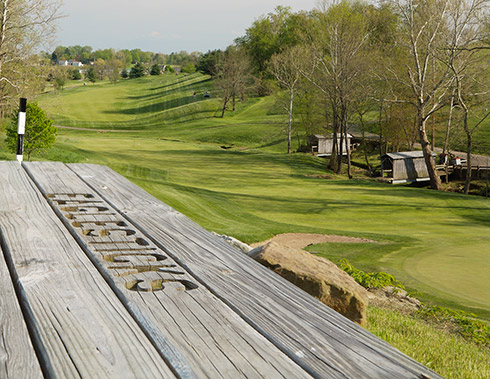
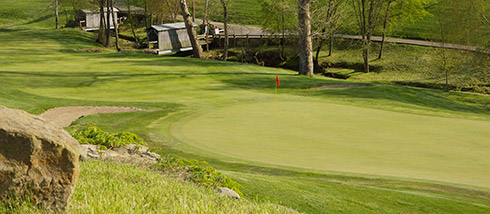
Two looks at the 11th green as seen from the tee of the par-three 17th. This par five plays 591 yards downhill from the back tees, so most golfers will be laying up and coming into the green with a short iron or wedge.
The 18th travels in the opposite direction of the 11th and plays 541 yards. Despite yanking a drive so far left I found the parallel ninth fairway, I was able to reach this green comfortably. Golfers who find the correct fairway will likely have little problem doing so as well, but they’ll be hitting to a green that’s well protected by mounds and deep bunkers. The best angle is actually from well left – where I happened to be – with a high cut if possible. The 18th is one of the more heavily bunkered holes on the course as well, though many of the larger bunkers are apparently more for intimidation, as they are past the drive landing area but short of any layup area.
All told, the par fives offer a varied and significant challenge. The downhill third is easily reachable, and both it and the 11th are simply fun driving holes – it’s not often we get to hit a tee shot downhill like this. It’s fun! But hidden among all that fun lurks a little danger for wayward or overly aggressive shots. Creeks and slopes will gobble up and toss your ball around, so temper your aggressive streak for success here.
The strength of any golf course is often its par fours, primarily because there are so many of them. Eagle Sticks has the standard 10, ranging in length from 338 to 479 from the back tees. Eagle Sticks has perhaps some of the best variety in par fours I’ve seen. The holes reward creativity and golfers who know when to press the pedal and when to play it safe. Get those backwards and your scores rocket skyward.
Let me highlight a few of the more interesting holes. I’ll start with the opener, an uphill, 458-yarder. As you can see below, the direct line to the hole is protected by a rather large bunker, making the hole play longer than measured. It’s only 200 yards to carry the gorge, but from an elevated tee, the carry looks much more substantial. The green is well contoured and protected to the middle right by a bunker and a slope. It’s rare these days to find bunkers anywhere but in front of greens, so I welcome the addition of bunkers protecting back pin positions.
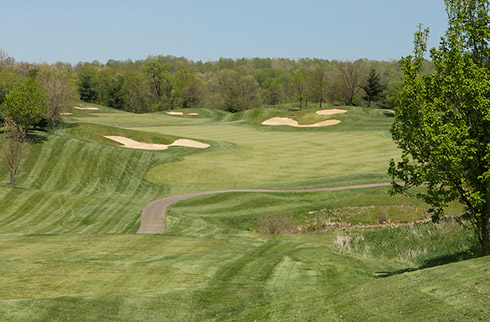
The 458-yard opening hole looks more intimidating than it plays. The gorge is only a 220-yard carry, but the bunker to the left is to be avoided.
The fourth and sixth, measuring 363 and 342 yards, are straightaway par fours. If you’ve got a “bunt driver” swing in your arsenal, use it here. The wide fairways are rather generous, but to score well you’ll want to be in the fairway so you can control your approach. A large slope bisects the fourth green, and getting close to any pin near that slope is tricky.
The seventh hole measures only 338 yards and plays downhill. The green is incredibly narrow and runs front to back. A steep slope up to a back-left appendage – where the hole was located the day I played – provides for an incredibly difficult pin position. The green is surrounded by bunkers, mounds, and if you miss far enough right, water. Just looking at the scorecard, players might think this is a drivable par four, but even with an iron off the tee I was happy to escape with a par. The green is simply that small. Hurzdan has accomplished something here rarely seen in modern golf: creation of a short, deadly par four.
The eight and ninth, at 437 and 453, follow. The eighth is difficult simply due to the intrusion of out-of-bounds left of the hole. The fairway is pinched at about 150 yards by a tree on the left, so the smart play is a cut up the right-hand side. The ninth plays uphill and to a green protected right by a spidery bunker and left by some tricky mounds.
On the back, the first par four is the 13th, and it’s the longest at 479 yards. The hole plays slightly uphill, and the fairway is accommodating to players who want to hit the ball a little harder than they’ve previously had to. The green is sloped rather heavily from front left to back right – just perfect to feed a ball the length of the green. This green, like many at Eagle Sticks, is open in front, allowing players to run the ball to the green and use the slopes to feed the ball to the hole. I’m not long, so I’m not a fan of long par fours, but this one gets everything right.
It’s followed by another of my favorite holes at Eagle Sticks, the 382-yard 14th. This hole doglegs right around a U-shaped bunker that tightens the landing area considerably. Choosing to be aggressive, I hit a large cut with the driver to follow the shape of the hole, but the smarter play is to find the fairway with a 3-wood or hybrid. The second shot makes this hole, though, as it plays to a long, skinny green that’s sloped front to back. From the right edge of the fairway, I had 100 yards to a back pin. The green is so skinny and the pin so far back that I estimated I had an area about ten square feet in which to land the ball to keep it near the green. Instead, I chose 8-iron, took a half swing, and put the ball on the fairway about 40 yards short of the pin and ten yards short of the green. It bounced a few times and began rolling. What seemed like two minutes later, the ball came to a stop eight feet short of the hole. My creativity was amply rewarded, and I love golf holes that allow for more than the rather American “fly it high and stick it” approach to golf.
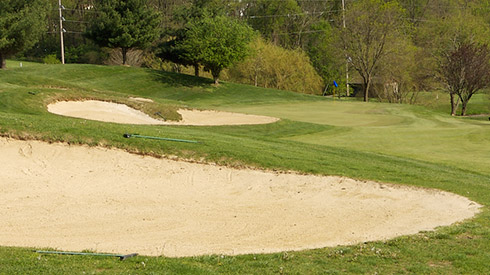
The 14th green at Eagle Sticks. Note how small the green gets towards the back where the hole is cut.
The 15th and 16th are adequate but unremarkable par fours measuring 439 and 346 yards. Both play to a plateau green that is well protected and heavily sloped, and the shorter of the two is fronted by a gully of sorts from which recovery is difficult.
I’ve got to admit continued confusion over distances at Eagle Sticks. For example, on the 458-yard opener, I had only 130 yards to a front pin. On the uphill 479-yard 13th, I had only 165. Both yardages were confirmed by the on-cart GPS as well as my laser range finder. The GPS units also verified that the holes were as long as listed. We were certainly on the correct and longest tees, neither hole is a dogleg, and the fairways didn’t appear to be rolling or bouncing more than normal. I joked a few times that I hit more 320-yard drives at Eagle Sticks than I had in two years prior, and I’m still not sure why.
Suffice to say, at 6,412 yards from the tips, Eagle Sticks is not a long course. It’s really rather short, especially with the mysteriously long drives. This makes it fun and enjoyable by everyone. The greens make this course what it is, because without an appropriate variety of shots, you’ll spend most of your time at Eagle Sticks chipping and pitching from awkward spots or putting up and down large slopes. Creativity, like my 60-yard 8-iron on the 14th hole, is rewarded handsomely.
That’s a rare find these days in the United States. Hurzdan appears to have made wonderful use of the rather small parcel of land he was given for this project, and seems to have moved little dirt in the process of sculpting the course. The fact that he probably moved a good bit of land to carve greens and fairways into the hillsides is a testament to the quality of the routing. Eagle Sticks feels as though it was discovered rather than created.
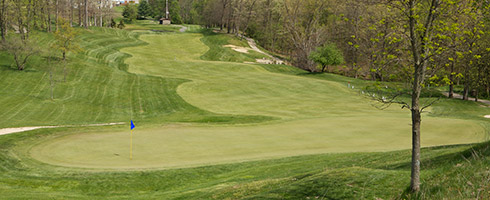
The eight hole, viewed from behind the green. This hole has one of the skinnier fairways on the course, yet plays 437 yards. Good luck.
Bang for the Buck
Eagle Sticks offers a variety of rates, and frankly, I’m not sure which apply at any given moment. The weekday rate is $40; the weekend rate is $50. Many courses charge weekend rates on Fridays and holidays, but my best guess is that a golfer playing Eagle Sticks on a Friday holiday will pay weekday rates.
Same-day replays cost only $15 for nine holes or $20 for 18. Golfers on a budget will pay only the $34 spring rate, and twilight golfers pay only $25. Seniors pay $35 and non-playing riders can tag along for only $7. Unfortunately, I don’t know exactly when spring ends and twilight begins or how old you must be to qualify as “senior.” The Eagle Sticks rates page, sadly, offers little insight. The best advice I can offer is to call the pro shop at (800) 782-4493 and ask.
The prices above include carts (and you’ll want a cart to tackle this hilly course), but does not include a $5 per-player refundable deposit for the GPS system. If you opt not to use the in-cart GPS, you can get back your $5. I’m not sure how players would be billed if one player wants to use the GPS system and the other does not, and frankly, I find this refundable deposit stuff too nickel-and-dimey for my taste. For all intents and purposes, add $5 to most of the prices quoted above. So, for between $30 and $55, a golfer can play Eagle Sticks, with a cart and a GPS system.
I’ve played $80 courses that aren’t as fun and well designed as Eagle Sticks, and I’ve not played many less expensive courses that offer the same amount of diversity and splendor. Eagle Sticks, nestled between the strip malls and fast food restaurants on Maysville Pike, is a bargain among bargains. The twilight rate is a steal – so much so that you’re well advised to show up early in order to get one of the first twilight spots. They go quickly.
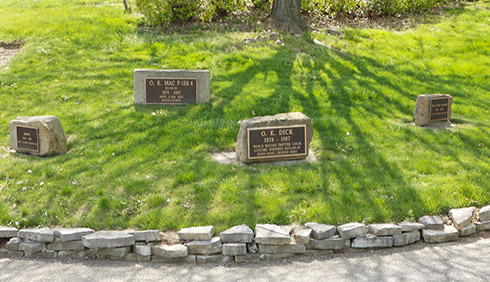
As I said, Eagle Sticks is built on an old horse farm. Left of the first tee lie the graves of several horses.
Conclusion
In this day and age of 7,400-yard courses, excessive “water features,” and brutality, Eagle Sticks stands apart from the rest. It’s a bit of a renaissance course – a throwback to the days when strategy won out over pure power, or at least unbridled power. Eagle Sticks makes you think in order to score well.
If you’re a grip-it-and-rip-it golfer with a poor short game, you’ll score badly here despite reaching a few of the par fives with irons and having lob wedge into several of the par fours. Eagle Sticks places a premium on shotmaking that goes beyond simply being able to fade or draw the ball on command. Creativity is rewarded.
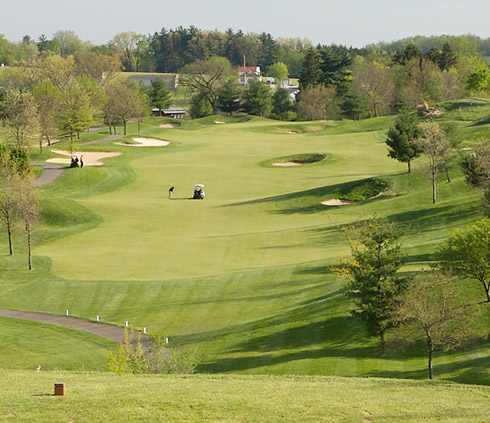
The 18th, an uphill par five, is reachable even if you find the ninth fairway left of the frame, as I discovered.
Scorecard
Hole 1 2 3 4 5 6 7 8 9 Out Par 4 3 5 4 3 4 4 4 4 35 Gold 458 171 493 363 151 342 338 437 453 3206 Blue 425 155 482 338 139 325 313 397 422 2996 Hdcp 3 13 7 9 17 11 15 5 1
Hole 10 11 12 13 14 15 16 17 18 In Par 3 5 3 4 4 4 4 3 5 35 Cran 193 591 180 479 382 439 346 151 541 3206 Back 168 567 165 458 358 424 323 140 525 3032 Hdcp 14 16 12 18 4 8 10 6 2
Totals Gold 70.1 120 6,412 yards Blue 68.3 117 6,028 yards White 65.5 108 5,397 yards Red 63.7 96 4,137 yards

Erik: A good thorough review. Definitely a worthwhile, reasonably priced course to check out if I’m in that neck of the woods.
Question about how you write these reviews (given the amount of detailed information) — are you making notes as you go along, do you sit at the 19th hole and ‘re-live’ the round, etc.? I was just curious.
Mohun: I too am amazed at how thorough Erik’s reviews are. I played with him that day and all I saw was a camera, lucky bounce on #2, and a pretty good golfer. Some guys just have a golf memory built for this type of thing.
I knew they’d allege luck. 🙂
I take a few pictures per hole in order to remind me of some specifics, but mostly I try to be observant. I’ll take a little extra time to look at parts of the hole where my ball may not be, at slopes, and so on. I’ve always been somewhat interested in golf course design and I can work the ball and play some different shots. Combine those along with the observation and it’s really just a question of asking yourself a few questions: “What is the designer trying to get me to do here?” “Do I like it?” Etc.
Thanks for the info.I will be playing,September 29.I haven’t played there,before.I really liked the photos. -CHUCK-
Good review. It’s only about an hour drive for me so I’ll have to check it out next year.